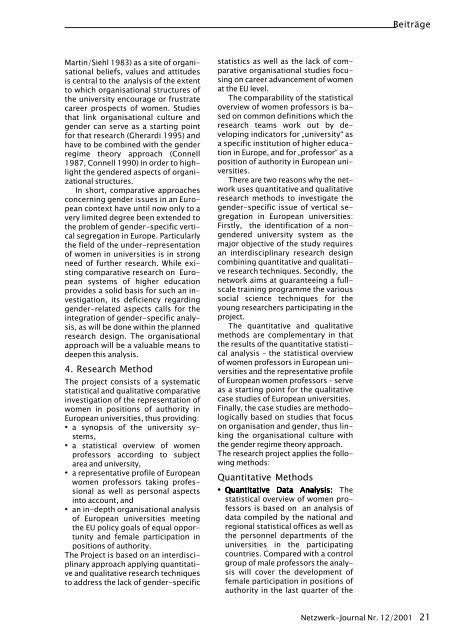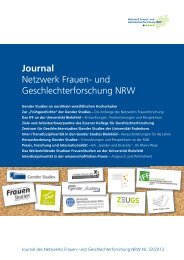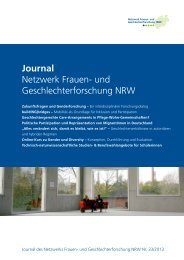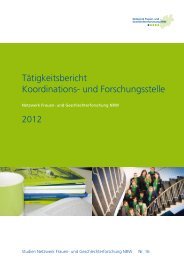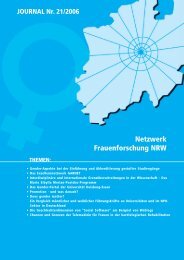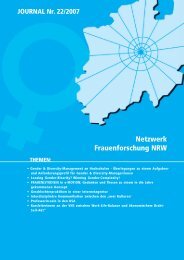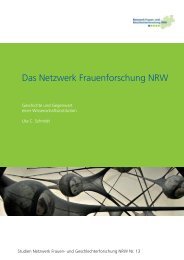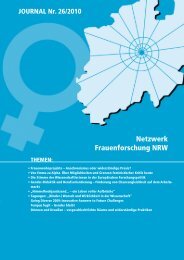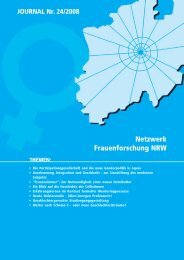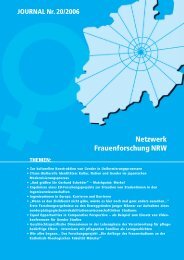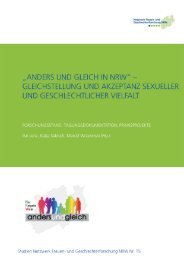Download (2 MB) - Netzwerk Frauen- und Geschlechterforschung ...
Download (2 MB) - Netzwerk Frauen- und Geschlechterforschung ...
Download (2 MB) - Netzwerk Frauen- und Geschlechterforschung ...
Erfolgreiche ePaper selbst erstellen
Machen Sie aus Ihren PDF Publikationen ein blätterbares Flipbook mit unserer einzigartigen Google optimierten e-Paper Software.
Martin/Siehl 1983) as a site of organisational<br />
beliefs, values and attitudes<br />
is central to the analysis of the extent<br />
to which organisational structures of<br />
the university encourage or frustrate<br />
career prospects of women. Studies<br />
that link organisational culture and<br />
gender can serve as a starting point<br />
for that research (Gherardi 1995) and<br />
have to be combined with the gender<br />
regime theory approach (Connell<br />
1987, Connell 1990) in order to highlight<br />
the gendered aspects of organizational<br />
structures.<br />
In short, comparative approaches<br />
concerning gender issues in an European<br />
context have until now only to a<br />
very limited degree been extended to<br />
the problem of gender-specific vertical<br />
segregation in Europe. Particularly<br />
the field of the <strong>und</strong>er-representation<br />
of women in universities is in strong<br />
need of further research. While existing<br />
comparative research on European<br />
systems of higher education<br />
provides a solid basis for such an investigation,<br />
its deficiency regarding<br />
gender-related aspects calls for the<br />
integration of gender-specific analysis,<br />
as will be done within the planned<br />
research design. The organisational<br />
approach will be a valuable means to<br />
deepen this analysis.<br />
4. Research Method<br />
The project consists of a systematic<br />
statistical and qualitative comparative<br />
investigation of the representation of<br />
women in positions of authority in<br />
European universities, thus providing:<br />
• a synopsis of the university systems,<br />
• a statistical overview of women<br />
professors according to subject<br />
area and university,<br />
• a representative profile of European<br />
women professors taking professional<br />
as well as personal aspects<br />
into account, and<br />
• an in-depth organisational analysis<br />
of European universities meeting<br />
the EU policy goals of equal opportunity<br />
and female participation in<br />
positions of authority.<br />
The Project is based on an interdisciplinary<br />
approach applying quantitative<br />
and qualitative research techniques<br />
to address the lack of gender-specific<br />
statistics as well as the lack of comparative<br />
organisational studies focusing<br />
on career advancement of women<br />
at the EU level.<br />
The comparability of the statistical<br />
overview of women professors is based<br />
on common definitions which the<br />
research teams work out by developing<br />
indicators for „university“ as<br />
a specific institution of higher education<br />
in Europe, and for „professor“ as a<br />
position of authority in European universities.<br />
There are two reasons why the network<br />
uses quantitative and qualitative<br />
research methods to investigate the<br />
gender-specific issue of vertical segregation<br />
in European universities:<br />
Firstly, the identification of a nongendered<br />
university system as the<br />
major objective of the study requires<br />
an interdisciplinary research design<br />
combining quantitative and qualitative<br />
research techniques. Secondly, the<br />
network aims at guaranteeing a fullscale<br />
training programme the various<br />
social science techniques for the<br />
young researchers participating in the<br />
project.<br />
The quantitative and qualitative<br />
methods are complementary in that<br />
the results of the quantitative statistical<br />
analysis – the statistical overview<br />
of women professors in European universities<br />
and the representative profile<br />
of European women professors – serve<br />
as a starting point for the qualitative<br />
case studies of European universities.<br />
Finally, the case studies are methodologically<br />
based on studies that focus<br />
on organisation and gender, thus linking<br />
the organisational culture with<br />
the gender regime theory approach.<br />
The research project applies the following<br />
methods:<br />
Quantitative Methods<br />
• Quantitative Quantitative Data Data Data Analysis: Analysis: The<br />
statistical overview of women professors<br />
is based on an analysis of<br />
data compiled by the national and<br />
regional statistical offices as well as<br />
the personnel departments of the<br />
universities in the participating<br />
countries. Compared with a control<br />
group of male professors the analysis<br />
will cover the development of<br />
female participation in positions of<br />
authority in the last quarter of the<br />
Beiträge<br />
<strong>Netzwerk</strong>-Journal Nr. 12/2001 21


